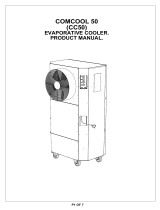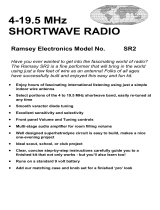Page is loading ...

©2003 Hamtronics, Inc.;
Hilton NY; USA. All rights reserved. Hamtronics is a registered trademark. Revised:
10/2/07
-
Page
1
-
GENERAL DESCRIPTION.
The CC-( ) series VHF Receiving
Converter modules are designed to
amplify and convert the frequency of
vhf signals in specific bands to 28-30
MHz.
The input and output connectors
are BNC type when the unit is sup-
plied in a case and RCA type when
the unit is supplied without a case.
The Converter is used to convert
vhf frequencies in a block down to
28-30 MHz so they can be heard on
a 10 meter receiver.
CRYSTALS.
The converter uses crystals in
HC-50/u (wire lead) holders. They
are soldered to the board.
We can provide either standard or
special frequency crytals for the con-
verter. Crystals are cut for parallel
resonance with 32pf load capaci-
tance. The following table gives crys-
tal frequencies for standard models.
Model Crystal Formula
CC50 22.0000 X = RF-IF
CC144 12.8889 X = (RF-IF)/9
CC145 13.0000 X = (RF-IF)/9
CC146 13.1111 X = (RF-IF)/9
CC222 21.5556 X = (RF-IF)/9
For purposes of determining cry-
stal, substitute the frequency of the
low end of the band of interest. I.e.,
the lowest frequency in the input
band is "RF" and the lowest output
frequency is "IF". For example, for
the CC144, 144 MHz is the bottom
end of the input band and this is
translated to 28 MHz in the output
band; so those frequencies are used
for the formula.
Hamtronics stocks crystals for the
popular frequency schemes (listed
above), and we will be glad to order
any special crystals.
MOUNTING AND
INTERCONNECTIONS.
If the unit was not ordered with
optional case, the pc board is easily
mounted to a chassis or panel with
4-40 screws and threaded standoffs
using the holes provided in the four
corners. A mounting kit is available
(see rear of catalog).
The i-f output should be con-
nected to the antenna input of the hf
receiver.
+13.6Vdc should be connected to
power pad E1.
INSTALLATION.
Installation depends on the type
of converter ordered. Connect J1 to
the vhf antenna and J2 to the input
of the receiver used for listening.
RCA plugs are used for boards with-
out a case. BNC plugs are used for
units supplied with a case.
Always use best quality low-loss
coax at uhf frequencies. We sell very
good rf-type RCA plugs, called by
part number A5. These are highly
recommended for best performance.
The power terminal on the pc
board or the feedthrough terminal on
the front of the case should be sol-
dered to a source of +12 to +14 Vdc,
preferably a regulated power supply.
Be sure that the same power
supply is not connected to any de-
vices which could produce damaging
voltage transients, for example, mo-
tors or relay coils. Reverse diodes
should be used across such devices
to limit transient pulses. The con-
verter draws about 25 mA.
ALIGNMENT AND TESTING.
The most difficult part of align-
ment is obtaining a stable test signal.
If you don't have access to a vhf sig-
nal generator, it is possible to use a
strong signal on the air.
➠
A tuning tool of the proper
type must be used to avoid cracking
the slugs in the coils. This is a .060"
square slot type tool. The slugs are
teflon coated; so they turn easily.
However, if a loosely fitting tool or a
tool only partially inserted in the slot
is allowed to slip in the slot, the
sideways force cracks the powdered
iron slug. Should this happen, the
slug must be drilled out and re-
placed. Variable capacitor C15 is ad-
justed with an insulated tool with a
small metal (slot type) bit in the end.
(See A2 and A28 Tuning Tools in
catalog.)
a. Connect a source of +12 to
+13.6Vdc to E1.
b. Connect signal source to J1,
and connect J2 to receiver used as
an i-f. Set both to the center of the
range you want to use. Note that
gain will be greatest at and near the
frequency used for alignment; so if
you want to emphasis one end of the
band, tune in the center of the range
you want to emphasize, for instance
for 144-145 operation, use
144.5MHz for alignment.
c. Connect dc voltmeter to TP1,
which is a pad in the center of the
board.
d. Adjust oscillator coils L7 and
L8 alternately for a peak (about 1 to
2.5 Vdc). Note that indication may
be zero when tuning far off peak on
either side.
e. With a moderately strong sig-
nal applied to the converter, tune in
the signal on the receiver.
f. Alternately adjust multiplier
coils L9 and L10, rf coils L2, L3, and
L4, and IF coils L5 and L6 for maxi-
mum response.
Repeat adjustment to work out
any interactions between coils. Re-
duce input signal to a fairly low level
for final adjustment. There may be
some benefit to readjusting input coil
L2 slightly for best noise figure,
which you can do by ear by tuning
for best quieting on a weak signal.
g. After initial alignment, try de-
tuning L7 and L8 alternately to find
the combination resulting in the best
sensitivity. Sometimes, less drive to
Q4 results in better noise figure be-
cause the mixer injection is opti-
mized.
h. If a frequency counter is avail-
able, or if you have another way of
applying an accurate frequency at
the input, adjust variable capacitor
C15 to trim the oscillator exactly on
frequency.
The final sensitivity of the con-
verter should be about 0.1 to 0.2 uV
for 12 dB sinad after tuning, assum-
ing an i-f receiver of good sensitivity
is used with the converter.
OPERATION.
Operation is so simple, it is
hardly necessary to describe it.
However, some explanation of the
way broadband converters operate
may be helpful to you if you have not
used one before.
The converter operates by hetero-
dyning (mixing) an entire block of fre-
quencies down to a new band of
frequencies which your receiver is al-
ready capable of hearing. It does
this by mixing an oscilla-
tor/multiplier signal with the incom-
ing signals to produce the difference
of the two frequencies.
Thus, all the frequencies in the
incoming band are converted to new
frequencies a set value away from
HAMTRONICS® CC-(VHF) RECEIVING CONVERTERS
INSTALLATION & MAINTENANCE INSTRUCTIONS

©2003 Hamtronics, Inc.;
Hilton NY; USA. All rights reserved. Hamtronics is a registered trademark. Revised:
10/2/07
-
Page
2
-
the original frequencies. All the fre-
quencies still have the same relation-
ship to each other in the new spec-
trum.
As an example, use the CC144
Converter frequency scheme. To lis-
ten to 144.000 MHz, you would tune
your receiver to 28.000 MHz. To
hear 144.100 MHz, tune to 28.100;
to hear 144.105, tune to 28.105, etc.
TROUBLESHOOTING.
The usual troubleshooting tech-
niques of checking dc voltages at
transistor elements and tracing oscil-
lator injection signals with an rf
probe and voltmeter are appropriate
for this converter.
Current drain is typically about
10-20mA; this is a very good indica-
tion of any problems on the B+ line.
If no voltage is measured at TP1,
the emitter of the multiplier stage,
that is an indication that the rf level
from the oscillator is too low to drive
the base of the transistor into con-
duction.
Probably the most common trou-
bles, based on our experience, is
blown transistors or voltage regulator
ic due to reverse polarity or tran-
sients on the B+ line. Any relay coils
connected across the B+ line should
have a reverse diode connected di-
rectly across the relay coil to absorb
the reverse transient produced when
the relay is unkeyed.
Typical Dc Voltages.
Following are positive dc voltages
with respect to ground, measured
with an fet voltmeter on a sample
unit operating on 13.6Vdc. While
readings can vary widely without
necessarily indicating trouble, these
readings can be used in conjunction
with an organized troubleshooting
plan to help isolate the trouble.
XSTR E(S) B(G1) G2 C(D)
Q1 0 0 3.3 6.7
Q2 0 0 0 7.1
Q3 1.5 2.2 - 7.0
Q4 1.5 0 - 7.3
PARTS LIST FOR CC144,
CC145, CC146.
Ref Desig Value
C1 27pf
C2 56pf
C3-C4 .001µf
C5 18pf
C6 0.5pf
C7 18pf
C8 .001µf
C9 .01µf
C10 47pf
C11 4pf
C12 62pf
C13 220pf
C14 .001µf
C15 20pf red variable cap
C16 27pf
C17-C18 150pf
C19 .001µf
C20 68pf
C21 1pf
C22 62pf
C23-C24 .001µf
C25 27pf
C26 0.5pf
C27 27pf
C28 0.1µf
C29 100µf electrolytic
C30-C31 .001µf
J1-J2 RCA jacks
L1 0.33µH rf choke
L2-L4 2½ turn (red) coil
L5-L6 14½ turn (yel) coil
L7-L8 6½ turn (blu) coil
L9-L10 2½ turn (red) coil
Q1-Q2 BF-998 f.e.t.
Q3-Q4 MSC3130 rf xstr
R1 100K
R2 not used
R3-R4 100K
R5 10K
R6 22K
R7 1K
R8 680Ω
R9 100Ω
R10-R11 47Ω
R12-R14 100Ω
U1-U5 not assigned
U6 78L08
Y1 Crystal (see chart)
PARTS WHICH DIFFER FOR
CC50 CONVERTER.
Ref Desig Value
C1 82pf
C2 220pf
C5 56pf
C6 1pf
C7 62pf
C14 n/u
C20 82pf
C21 1pf
C22 82pf
L1 15µH choke
L2-L4 6½ turn coils
L7-L8 14½ turn coils
Y1 22.000 MHz
Note: The following
parts are not used:
Q4, C24-C27, L9-
L10, R7, R14. In-
stead, a jumper wire
must be tack sol-
dered to the bottom
of the board along
the path from what
normally is the base of Q4 down
through C25 and C26, with a dog leg
to cover both pads of C26 as shown
here.
PARTS WHICH DIFFER FOR
CC222 CONVERTER.
Ref Desig Value
C1 5pf
C2 not used
C5 6pf
C6 not used
C7 5pf
C20 39pf
C21 0.5pf
C22 39pf
C25 5pf
C26 not used
C27 7pf
Y1 21.5556 MHz

©2003 Hamtronics, Inc.;
Hilton NY; USA. All rights reserved. Hamtronics is a registered trademark. Revised:
10/2/07
-
Page
3
-
/


